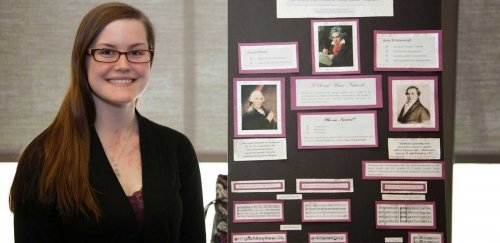Beethoven – Lone Genius or Collaborator?
- News & Events
- News
- Beethoven – Lone Genius or Collaborator?

RIC music performance major Cami Sylvia
The idea that a genius creates in isolation has been a long-held myth, which music performance major Cami Sylvia ’15 debunked in her study of Beethoven.
In an independent honors research project titled “Beethoven as Collaborator,” Sylvia discovered that Beethoven relied on feedback from composers and performers to write his early string quartets. She discussed her research at a RIC poster session attended by faculty, administrators and students.
Composer Ludwig van Beethoven did not begin his career writing for strings, said Sylvia. Beethoven was primarily a pianist – indeed, a virtuoso pianist. But it was his early teacher, Joseph Haydn – the father of the string quartet – who taught Beethoven how to write for strings.
Moreover, in tracing similarities between a Haydn and Beethoven early string quartet, Sylvia found that the Haydnesque model was present in much of Beethoven’s early works.
Ignaz Schuppanzigh, a virtuoso violinist, conductor and close friend of Beethoven, was also one of Beethoven’s collaborators, said Sylvia. “There are two important components to Schuppanzigh’s role as collaborator,” she said. “First, Schuppanzigh’s founding of the Razumovsky Quartet; and second, Schuppanzigh’s creation of a public concert series.”
As founder and conductor of the Razumovsky Quartet, Schuppanzigh allowed Beethoven to use his ensemble to premiere many of Beethoven’s new works. “Beethoven would pass around his sketches to the musicians, get their feedback and make adjustments. And the feedback he received from the players influenced his writing,” she said.
Prior to Schuppanzigh’s creation of the first public concert series, chamber music was performed in private parlors before a small, elite audience. “With a public concert series, you have more listeners,” said Sylvia. “I found that, because of the increased size, Beethoven made further adjustments to his quartet writing to engage a much larger audience. For instance, there are elements of theatre that made its way into Beethoven’s string quartets.“
“Imagine that you have two main characters – one is strong and fierce and the other is sweet and gentle. In Beethoven’s quartets, you can’t see the characters on stage; you hear them in the music. Character types are found throughout his early compositions,” she said.
Ultimately, she said, a work of genius is rarely created in isolation but comes about through the exchange of ideas, as it did for Beethoven.
Sylvia’s research project was one of 19 thought-provoking, independent research projects conducted by graduating seniors in the College Honors Program and members of the Rhode Island College Chapter of Sigma XI (the Scientific Research Society).
Secretary of the Scientific Research Society, RIC Professor James Magyar noted that “poster sessions are an important way for students to share their research with others. They gain the experience of organizing the experiments and results, preparing a poster and explaining their work to a friendly audience. The poster session is also a chance for faculty and academic leaders at the college to learn more about the work that is going on here.”
Sylvia, a violinist, will begin her master’s degree in music performance this fall at SUNY Purchase and then perform full time in a symphony orchestra.
